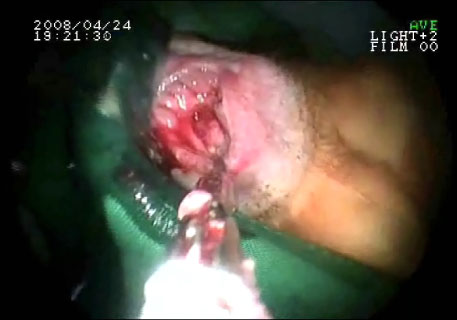J Korean Surg Soc.
2010 Nov;79(5):362-368. 10.4174/jkss.2010.79.5.362.
Endoscopic Cecectomy with Hybrid Natural Orifice Transluminal Endoscopic Surgery (NOTES) in Canine Models
- Affiliations
-
- 1Chung Chong Surgical Clinic, Daejeon, Korea.
- 2Department of Surgery, Chungnam National University College of Veterinary Medicine, Daejeon, Korea.
- 3Department of Surgery, Research Institute for Medical Science, Chungnam National University College of Medicine, Daejeon, Korea. jkim@cnu.ac.kr
- KMID: 2212043
- DOI: http://doi.org/10.4174/jkss.2010.79.5.362
Abstract
- PURPOSE
Natural orifice transluminal endoscopic surgery (NOTES) is a new operation technique that utilizes natural orifices of the patient's body with the intention to puncture hollow viscera in order to insert an endoscope into a peritoneal cavity for incisionless surgery. The aim of this study was to evaluate the safety and feasibility of endoscopic cecectomy through the rectum in one dog and the vagina in another dog.
METHODS
This study was performed in two beagle dogs for rectal and vaginal approaches. A five-milimeter trocar was inserted into the abdominal cavity by the Hasson method and intra-abdominal pressure was maintained at 5 mmHg with CO2. After pneumoperitoneum was accomplished, the rectum or vagina was incised with a needle knife and a one-channel gastric endoscope was inserted into the abdominal cavity. Counter-traction was performed using a laparoscopic grasper introduced via the 5 mm trocar in the umbilicus. The cecum was dissected from the base by using a needle knife with the aid of laparoscopic counter-traction. The resected cecum was retrieved through the anus or vagina without pouch bag. The incised rectum was closed by using 90-degree endoclips whereas the incised vagina was not repaired.
RESULTS
Cecectomies were successfully performed with both transrectal and transvaginal routes. Both cases had no complication and recovered from surgery uneventfully.
CONCLUSION
Endoscopic cecectomy with hybrid NOTES are feasible and safe. With the improvement of surgical experiences and further instrumental development, NOTES can be one option for human intestinal surgery.
Keyword
MeSH Terms
Figure
Reference
-
1. Rattner D, Kalloo A. ASGE/SAGES Working Group. ASGE/SAGES Working Group on Natural Orifice Translumenal Endoscopic Surgery. October 2005. Surg Endosc. 2006. 20:329–333.2. Kalloo AN, Singh VK, Jagannath SB, Niiyama H, Hill SL, Vaughn CA, et al. Flexible transgastric peritoneoscopy: a novel approach to diagnostic and therapeutic interventions in the peritoneal cavity. Gastrointest Endosc. 2004. 60:114–117.3. Pai RD, Fong DG, Bundga ME, Odze RD, Rattner DW, Thompson CC. Transcolonic endoscopic cholecystectomy: a NOTES survival study in a porcine model (with video). Gastrointest Endosc. 2006. 64:428–434.4. Rao GV, Reddy DN, Banerjee R. NOTES: human experience. Gastrointest Endosc Clin N Am. 2008. 18:361–370.5. Bessler M, Stevens PD, Milone L, Parikh M, Fowler D. Transvaginal laparoscopically assisted endoscopic cholecystectomy: a hybrid approach to natural orifice surgery. Gastrointest Endosc. 2007. 66:1243–1245.6. Marescaux J, Dallemagne B, Perretta S, Wattiez A, Mutter D, Coumaros D. Surgery without scars: report of transluminal cholecystectomy in a human being. Arch Surg. 2007. 142:823–826.7. Kim YI, Park JH, Lee SI, Jeong SM, Kim JY. Transgastric gastroscopic intra-abdominal exploration in a female dog model: NOTES (natural orifice transluminal endoscopic surgery). J Korean Soc Coloproctol. 2007. 23:397–402.8. Sohn DK, Jeong SY, Cho YB, Park JW, Lee WY, Choi GS, et al. The first transcolonic cholecystectomy in Korea: a NOTES survival study in an animal model. J Korean Surg Soc. 2008. 75:64–69.9. Wagh MS, Merrifield BF, Thompson CC. Endoscopic transgastric abdominal exploration and organ resection: initial experience in a porcine model. Clin Gastroenterol Hepatol. 2005. 3:892–896.10. Clayman RV, Box GN, Abraham JB, Lee HJ, Deane LA, Sargent ER, et al. Rapid communication: transvaginal single-port NOTES nephrectomy: initial laboratory experience. J Endourol. 2007. 21:640–644.11. Box G, Averch T, Cadeddu J, Cherullo E, Clayman R, Desai M, et al. Nomenclature of natural orifice translumenal endoscopic surgery (NOTES) and laparoendoscopic single-site surgery (LESS) procedures in urology. J Endourol. 2008. 22:2575–2581.12. Whiteford MH, Denk PM, Swanström LL. Feasibility of radical sigmoid colectomy performed as natural orifice translumenal endoscopic surgery (NOTES) using transanal endoscopic microsurgery. Surg Endosc. 2007. 21:1870–1874.13. Hiki N, Yamamoto Y, Fukunaga T, Yamaguchi T, Nunobe S, Tokunaga M, et al. Laparoscopic and endoscopic cooperative surgery for gastrointestinal stromal tumor dissection. Surg Endosc. 2008. 22:1729–1735.14. Hulka JF, Reich H. Textbook of Laparoscopy. 1994. 2nd ed. Philadelphia: W.B. Saunders;47–50.15. O JT, Park DE, Chae KM. Postoperative pain differences between different insufflation pressures on laparoscopic cholecystectomy. J Korean Surg Soc. 2006. 70:307–311.16. Sporn E, Bachman SL, Miedema BW, Loy TS, Calaluce R, Thaler K. Endoscopic colotomy closure for natural orifice transluminal endoscopic surgery using a T-fastener prototype in comparison to conventional laparoscopic suture closure. Gastrointest Endosc. 2008. 68:724–730.17. Zornig C, Mofid H, Emmermann A, Alm M, von Waldenfels HA, Felixmüller C. Scarless cholecystectomy with combined transvaginal and transumbilical approach in a series of 20 patients. Surg Endosc. 2008. 22:1427–1429.18. Abbott DJ, Becke C, Rothstein RI, Peine WJ. Design of an endoluminal NOTES robotic system. Proceedings of the 2007 IEEE/RSJ International Conference on Intelligent Robotics and Systems. 2007 Oct 29-Nov 2; San Diego, CA. 410–416.19. Swanstrom LL, Whiteford M, Khajanchee Y. Developing essential tools to enable transgastric surgery. Surg Endosc. 2008. 22:600–604.20. Lehman AC, Dumpert J, Wood NA, Redden L, Visty AQ, Farritor S, et al. Natural orifice cholecystectomy using a miniature robot. Surg Endosc. 2009. 23:260–266.
- Full Text Links
- Actions
-
Cited
- CITED
-
- Close
- Share
- Similar articles
-
- Recent development of innovative resection methods for gastric neoplasms using hybrid natural orifice transluminal endoscopic surgery approach
- Natural Orifice Transluminal Endoscopic Surgery and Upper Gastrointestinal Tract
- Anesthetic management of transoral natural orifice transluminal endoscopic surgery: two cases report
- Natural Orifice Transluminal Endoscopic Surgery (NOTES)
- 4 Cases of Transgastric Endoscopic Cholecystectomy in Canine and Porcine Models












